2017 Hyundai Elantra weight
[x] Cancel search: weightPage 9 of 571
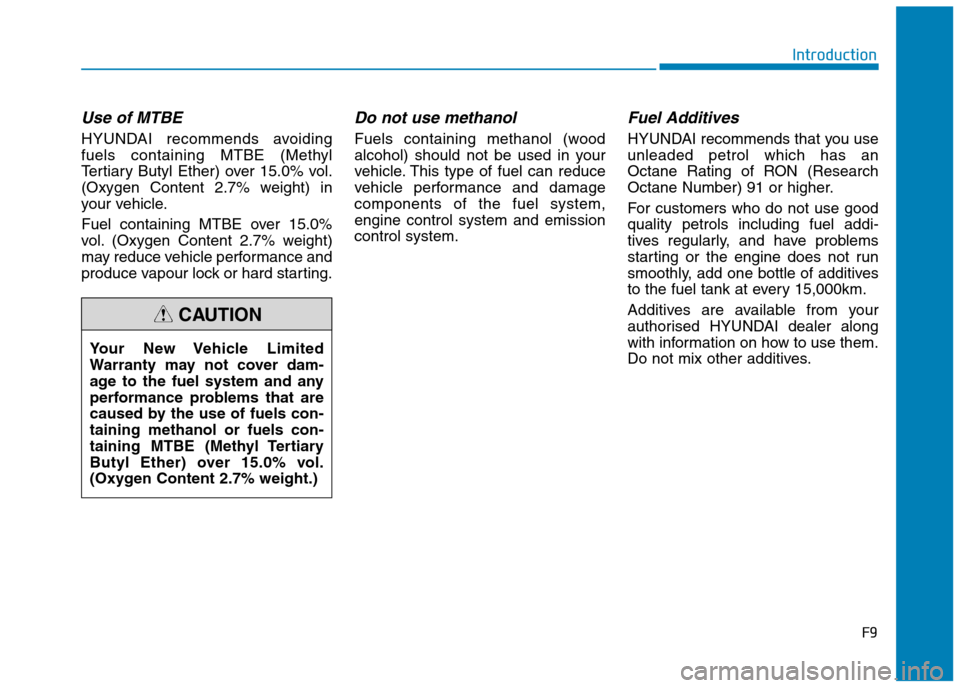
F9
Introduction
Use of MTBE
HYUNDAI recommends avoiding
fuels containing MTBE (Methyl
Te r t i a r y B u t y l E t h e r ) o v e r 1 5 . 0 % v o l .
(Oxygen Content 2.7% weight) in
your vehicle.
Fuel containing MTBE over 15.0%
vol. (Oxygen Content 2.7% weight)
may reduce vehicle performance and
produce vapour lock or hard starting.
Do not use methanol
Fuels containing methanol (wood
alcohol) should not be used in your
vehicle. This type of fuel can reduce
vehicle performance and damage
components of the fuel system,
engine control system and emission
control system.
Fuel Additives
HYUNDAI recommends that you use
unleaded petrol which has an
Octane Rating of RON (Research
Octane Number) 91 or higher.
For customers who do not use good
quality petrols including fuel addi-
tives regularly, and have problems
starting or the engine does not run
smoothly, add one bottle of additives
to the fuel tank at every 15,000km.
Additives are available from your
authorised HYUNDAI dealer along
with information on how to use them.
Do not mix other additives.Yo u r N e w Ve h i c l e L i m i t e d
Warranty may not cover dam-
age to the fuel system and any
performance problems that are
caused by the use of fuels con-
taining methanol or fuels con-
taining MTBE (Methyl Tertiary
Butyl Ether) over 15.0% vol.
(Oxygen Content 2.7% weight.)
CAUTION
Page 59 of 571
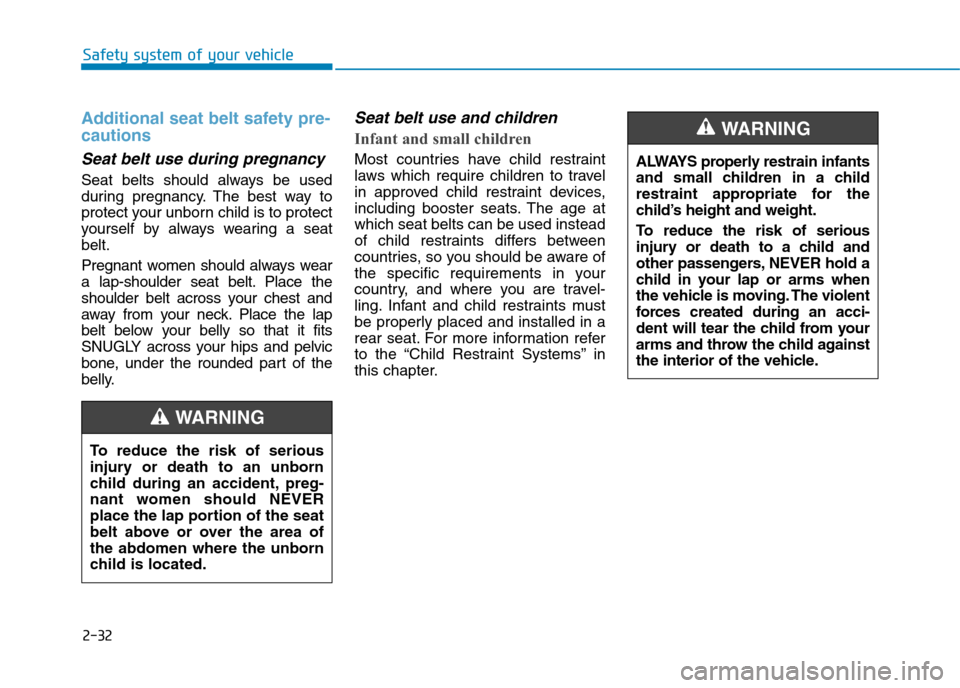
2-32
Safety system of your vehicle
Additional seat belt safety pre-
cautions
Seat belt use during pregnancy
Seat belts should always be used
during pregnancy. The best way to
protect your unborn child is to protect
yourself by always wearing a seat
belt.
Pregnant women should always wear
a lap-shoulder seat belt. Place the
shoulder belt across your chest and
away from your neck. Place the lap
belt below your belly so that it fits
SNUGLY across your hips and pelvic
bone, under the rounded part of the
belly.
Seat belt use and children
Infant and small children
Most countries have child restraint
laws which require children to travel
in approved child restraint devices,
including booster seats. The age at
which seat belts can be used instead
of child restraints differs between
countries, so you should be aware of
the specific requirements in your
country, and where you are travel-
ling. Infant and child restraints must
be properly placed and installed in a
rear seat. For more information refer
to the “Child Restraint Systems” in
this chapter.
To r e d u c e t h e r i s k o f s e r i o u s
injury or death to an unborn
child during an accident, preg-
nant women should NEVER
place the lap portion of the seat
belt above or over the area of
the abdomen where the unborn
child is located.
WA R N I N G
ALWAYS properly restrain infants
and small children in a child
restraint appropriate for the
child’s height and weight.
To r e d u c e t h e r i s k o f s e r i o u s
injury or death to a child and
other passengers, NEVER hold a
child in your lap or arms when
the vehicle is moving. The violent
forces created during an acci-
dent will tear the child from your
arms and throw the child against
the interior of the vehicle.
WA R N I N G
Page 60 of 571
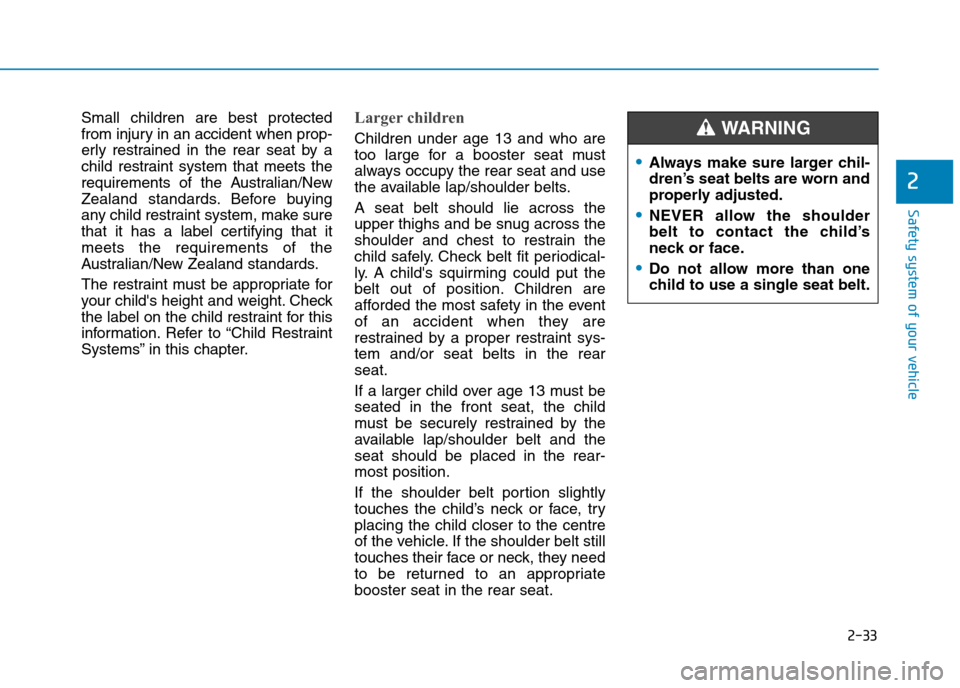
2-33
Safety system of your vehicle
2
Small children are best protected
from injury in an accident when prop-
erly restrained in the rear seat by a
child restraint system that meets the
requirements of the Australian/New
Zealand standards. Before buying
any child restraint system, make sure
that it has a label certifying that it
meets the requirements of the
Australian/New Zealand standards.
The restraint must be appropriate for
your child's height and weight. Check
the label on the child restraint for this
information. Refer to “Child Restraint
Systems” in this chapter.
Larger children
Children under age 13 and who are
too large for a booster seat must
always occupy the rear seat and use
the available lap/shoulder belts.
A seat belt should lie across the
upper thighs and be snug across the
shoulder and chest to restrain the
child safely. Check belt fit periodical-
ly. A child's squirming could put the
belt out of position. Children are
afforded the most safety in the event
of an accident when they are
restrained by a proper restraint sys-
tem and/or seat belts in the rear
seat.
If a larger child over age 13 must be
seated in the front seat, the child
must be securely restrained by the
available lap/shoulder belt and the
seat should be placed in the rear-
most position.
If the shoulder belt portion slightly
touches the child’s neck or face, try
placing the child closer to the centre
of the vehicle. If the shoulder belt still
touches their face or neck, they need
to be returned to an appropriate
booster seat in the rear seat.
•Always make sure larger chil-
dren’s seat belts are worn and
properly adjusted.
•NEVER allow the shoulder
belt to contact the child’s
neck or face.
•Do not allow more than one
child to use a single seat belt.
WA R N I N G
Page 63 of 571

2-36
Safety system of your vehicle
Children always in the rear
seat
Children under age 13 must always
ride in the rear seats and must
always be properly restrained to min-
imise the risk of injury in an accident,
sudden stop or sudden manoeuvre.
According to accident statistics, chil-
dren are safer when properly
restrained in the rear seats than in
the front seat. Children too large for a
Child Restraint System must use the
seat belts provided.
Most countries have Child Restraint
System laws which require children
to travel in approved Child Restraint
Systems. The laws governing the
age or height/weight restrictions at
which seat belts can be used instead
of Child Restraint Systems differs
between countries, so you should be
aware of the specific requirements in
your country, and where you are trav-
elling.
Child Restraint Systems must be
properly placed and installed in the
rear seat. You must use a commer-
cially available Child Restraint
System that meets the requirements
of the Australian/New Zealand stan-
dards.
Child Restraint Systems are general-
ly designed to be secured in a vehi-
cle seat by lap belt or the lap belt
portion of a lap/shoulder belt and a
top tether anchorage, or by ISOFIX
lower anchorages and a top tether
anchorage, in the rear seats of the
vehicle.
CCHHIILLDD RREESSTTRRAAIINNTT SSYYSSTTEEMM ((CCRRSS))
Always properly restrain chil-
dren in the rear seats of the
vehicle, unless the air bag on
the front passenger seat is
deactivated.
Children of all ages are safer
when restrained in the rear seat.
A child riding in the front pas-
senger seat can be forcefully
struck by an inflating air bag
resulting in SERIOUS INJURY
or DEATH.
WA R N I N G
Page 64 of 571
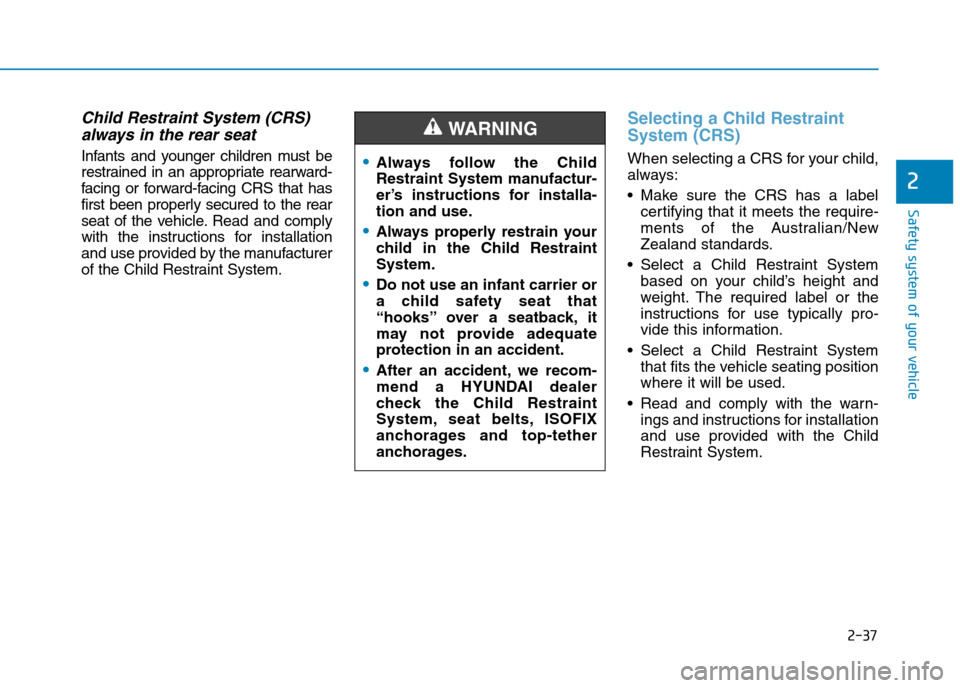
2-37
Safety system of your vehicle
Child Restraint System (CRS)
always in the rear seat
Infants and younger children must be
restrained in an appropriate rearward-
facing or forward-facing CRS that has
first been properly secured to the rear
seat of the vehicle. Read and comply
with the instructions for installation
and use provided by the manufacturer
of the Child Restraint System.
Selecting a Child Restraint
System (CRS)
When selecting a CRS for your child,
always:
•Make sure the CRS has a label
certifying that it meets the require-
ments of the Australian/New
Zealand standards.
•Select a Child Restraint System
based on your child’s height and
weight. The required label or the
instructions for use typically pro-
vide this information.
•Select a Child Restraint System
that fits the vehicle seating position
where it will be used.
•Read and comply with the warn-
ings and instructions for installation
and use provided with the Child
Restraint System.
2
•Always follow the Child
Restraint System manufactur-
er’s instructions for installa-
tion and use.
•Always properly restrain your
child in the Child Restraint
System.
•Do not use an infant carrier or
a child safety seat that
“hooks” over a seatback, it
may not provide adequate
protection in an accident.
•After an accident, we recom-
mend a HYUNDAI dealer
check the Child Restraint
System, seat belts, ISOFIX
anchorages and top-tether
anchorages.
WA R N I N G
Page 65 of 571
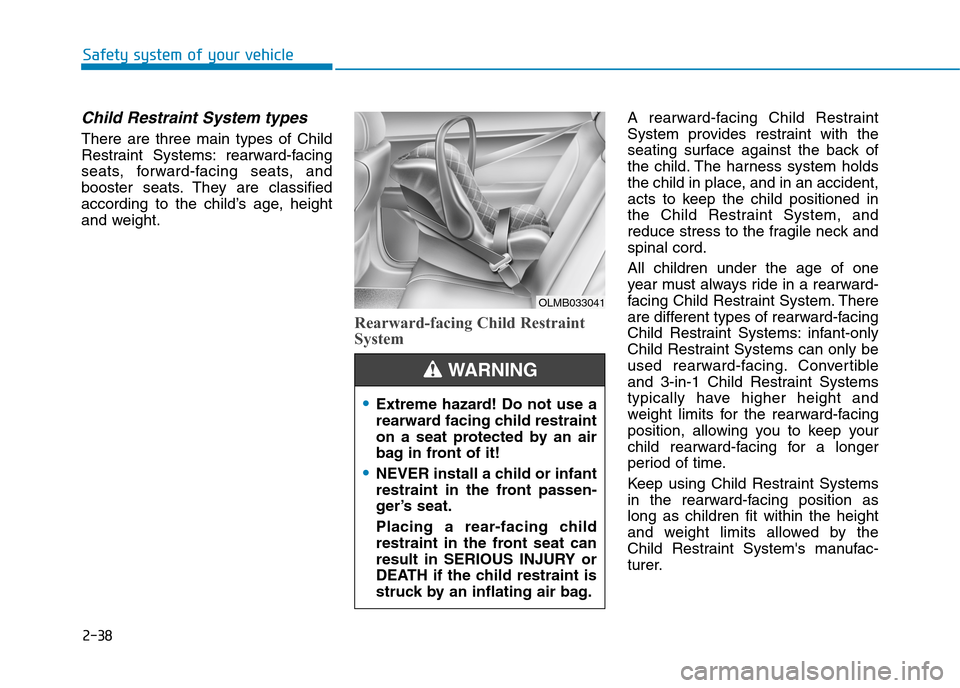
2-38
Child Restraint System types
There are three main types of Child
Restraint Systems: rearward-facing
seats, forward-facing seats, and
booster seats. They are classified
according to the child’s age, height
and weight.
Rearward-facing Child Restraint
System
A rearward-facing Child Restraint
System provides restraint with the
seating surface against the back of
the child. The harness system holds
the child in place, and in an accident,
acts to keep the child positioned in
the Child Restraint System, and
reduce stress to the fragile neck and
spinal cord.
All children under the age of one
year must always ride in a rearward-
facing Child Restraint System. There
are different types of rearward-facing
Child Restraint Systems: infant-only
Child Restraint Systems can only be
used rearward-facing. Convertible
and 3-in-1 Child Restraint Systems
typically have higher height and
weight limits for the rearward-facing
position, allowing you to keep your
child rearward-facing for a longer
period of time.
Keep using Child Restraint Systems
in the rearward-facing position as
long as children fit within the height
and weight limits allowed by the
Child Restraint System's manufac-
turer.
Safety system of your vehicle
OLMB033041
•Extreme hazard! Do not use a
rearward facing child restraint
on a seat protected by an air
bag in front of it!
•NEVER install a child or infant
restraint in the front passen-
ger’s seat.
Placing a rear-facing child
restraint in the front seat can
result in SERIOUS INJURY or
DEATH if the child restraint is
struck by an inflating air bag.
WA R N I N G
Page 66 of 571
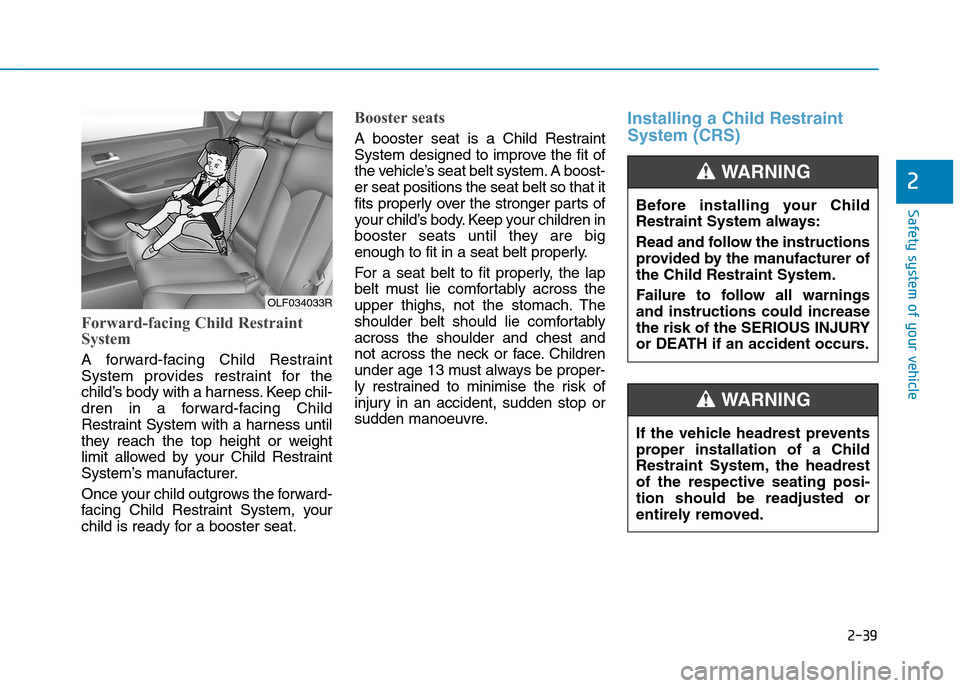
2-39
Safety system of your vehicle
2
Forward-facing Child Restraint
System
A forward-facing Child Restraint
System provides restraint for the
child’s body with a harness. Keep chil-
dren in a forward-facing Child
Restraint System with a harness until
they reach the top height or weight
limit allowed by your Child Restraint
System’s manufacturer.
Once your child outgrows the forward-
facing Child Restraint System, your
child is ready for a booster seat.
Booster seats
A booster seat is a Child Restraint
System designed to improve the fit of
the vehicle’s seat belt system. A boost-
er seat positions the seat belt so that it
fits properly over the stronger parts of
your child’s body. Keep your children in
booster seats until they are big
enough to fit in a seat belt properly.
For a seat belt to fit properly, the lap
belt must lie comfortably across the
upper thighs, not the stomach. The
shoulder belt should lie comfortably
across the shoulder and chest and
not across the neck or face. Children
under age 13 must always be proper-
ly restrained to minimise the risk of
injury in an accident, sudden stop or
sudden manoeuvre.
Installing a Child Restraint
System (CRS)
OLF034033R
Before installing your Child
Restraint System always:
Read and follow the instructions
provided by the manufacturer of
the Child Restraint System.
Failure to follow all warnings
and instructions could increase
the risk of the SERIOUS INJURY
or DEATH if an accident occurs.
WA R N I N G
If the vehicle headrest prevents
proper installation of a Child
Restraint System, the headrest
of the respective seating posi-
tion should be readjusted or
entirely removed.
WA R N I N G
Page 441 of 571

5-65
Driving your vehicle
5
Check battery and cables
Winter temperatures increase bat-
tery consumption.Inspect the bat-
tery and cables, as specified in the
chapter 7.The battery charging level
can be checked by an authorised
HYUNDAI dealer or in a service sta-
tion.
Change to "winter weight" oil if
necessary
In some regions during winter, it is
recommended to use the "winter
weight" oil with lower viscosity. For
further information, refer to chapter
8. When you are not sure about a
type of winter weight oil, consult an
authorised HYUNDAI dealer.
Check spark plugs and ignition
system
Inspect the spark plugs, as speci-
fied in chapter 7.If necessary,
replace them. Also check all ignition
wirings and components for any
cracks, wear-out, and damage.
To p r e v e n t l o c k s f r o m f r e e z i n g
To p r e v e n t t h e l o c k s f r o m b e i n g
frozen, spray approved de-icing fluid
or glycerin into key holes. When a
lock opening is already covered with
ice, spray approved de-icing fluid
over the ice to remove it. When an
internal part of a lock freezes, try to
thaw it with a heated key. Use the
heated key carefully to avoid an
injury.
Use approved window washer
anti-freeze solution in system
To p r e v e n t t h e w i n d o w w a s h e r f r o m
being frozen, add authorised window
washer anti-freeze solution, as spec-
ified on the window washer contain-
er. Window washer anti-freeze solu-
tion is available from an authorised
HYUNDAI dealer, and most vehicle
accessory outlets. Do not use engine
coolant or other types of anti-freeze
solution, to prevent any damage to
the vehicle paint.